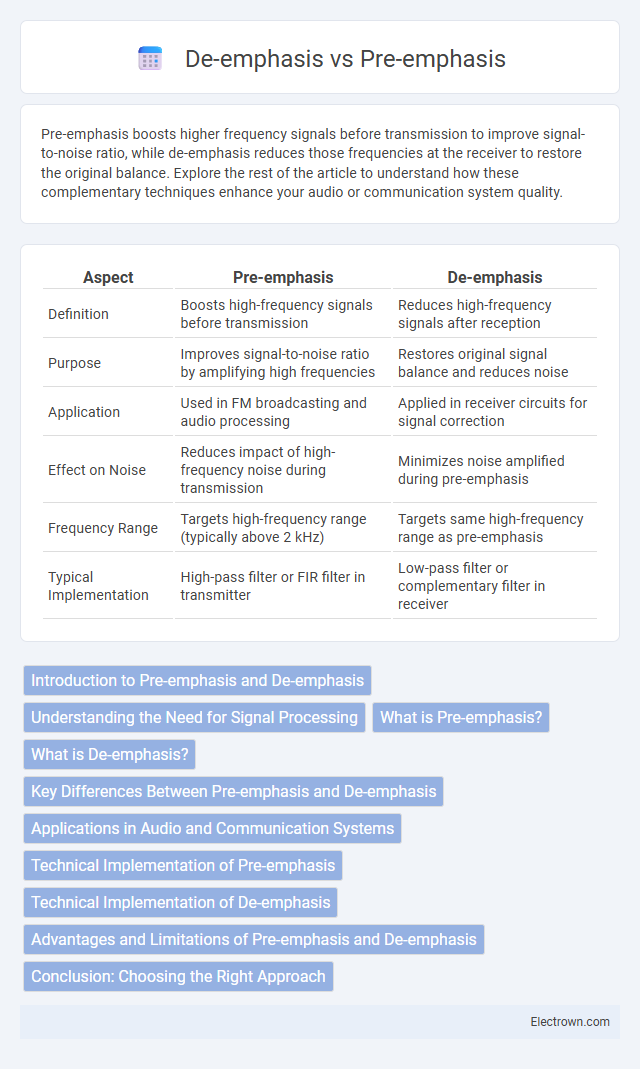Pre-emphasis boosts higher frequency signals before transmission to improve signal-to-noise ratio, while de-emphasis reduces those frequencies at the receiver to restore the original balance. Explore the rest of the article to understand how these complementary techniques enhance your audio or communication system quality.
Table of Comparison
| Aspect | Pre-emphasis | De-emphasis |
|---|---|---|
| Definition | Boosts high-frequency signals before transmission | Reduces high-frequency signals after reception |
| Purpose | Improves signal-to-noise ratio by amplifying high frequencies | Restores original signal balance and reduces noise |
| Application | Used in FM broadcasting and audio processing | Applied in receiver circuits for signal correction |
| Effect on Noise | Reduces impact of high-frequency noise during transmission | Minimizes noise amplified during pre-emphasis |
| Frequency Range | Targets high-frequency range (typically above 2 kHz) | Targets same high-frequency range as pre-emphasis |
| Typical Implementation | High-pass filter or FIR filter in transmitter | Low-pass filter or complementary filter in receiver |
Introduction to Pre-emphasis and De-emphasis
Pre-emphasis is a signal processing technique that amplifies higher frequency components to improve signal-to-noise ratio during transmission. De-emphasis complements this by attenuating those amplified frequencies at the receiver end, restoring the original signal balance. Your audio system benefits from this pair by minimizing noise and distortion, ensuring clearer sound quality.
Understanding the Need for Signal Processing
Pre-emphasis and de-emphasis are crucial signal processing techniques used to improve the quality and reliability of audio transmissions by compensating for high-frequency loss and noise. Pre-emphasis boosts the higher frequencies before transmission, while de-emphasis attenuates them upon reception to restore the original signal balance. Understanding these processes helps you optimize audio clarity and reduce distortion in communication systems.
What is Pre-emphasis?
Pre-emphasis is a signal processing technique that amplifies high-frequency components before transmission to improve the signal-to-noise ratio and reduce the effects of noise and interference. Commonly used in audio and communication systems, pre-emphasis boosts higher frequencies where noise tends to be more prominent, enhancing overall clarity and fidelity. This process is typically paired with de-emphasis at the receiver end to restore the original frequency balance and minimize distortion.
What is De-emphasis?
De-emphasis is a signal processing technique used to restore the original amplitude characteristics of an audio signal after it has undergone pre-emphasis, which boosts high-frequency components to improve signal-to-noise ratio during transmission or recording. This process reduces the amplified high frequencies back to their initial level, minimizing noise and distortion in audio reproduction. Commonly applied in FM broadcasting and audio recording, de-emphasis ensures accurate sound quality by compensating for the intentional frequency shaping introduced by pre-emphasis.
Key Differences Between Pre-emphasis and De-emphasis
Pre-emphasis involves boosting higher frequency signals during transmission to improve signal-to-noise ratio, while de-emphasis reduces those frequencies at the receiver to restore the original signal balance. You can typically find pre-emphasis applied in FM broadcasting and audio recording systems, whereas de-emphasis is essential for proper playback and noise reduction. The key difference lies in their function: pre-emphasis enhances signal clarity by emphasizing high frequencies before transmission, and de-emphasis compensates for this boost to achieve accurate audio reproduction.
Applications in Audio and Communication Systems
Pre-emphasis enhances high-frequency components in audio and communication systems to improve signal-to-noise ratio during transmission, while de-emphasis restores the original frequency balance at the receiver end to reduce noise and distortion. These techniques play a critical role in FM broadcasting, where pre-emphasis emphasizes higher frequencies before transmission and de-emphasis attenuates them properly during reception to maintain audio clarity. Your system's overall audio quality and reliability depend on the precise implementation of pre-emphasis and de-emphasis filters within the communication chain.
Technical Implementation of Pre-emphasis
Pre-emphasis involves amplifying high-frequency components of an audio signal before transmission using a specific filter that boosts frequencies above a set cutoff, typically around 2-3 kHz. This is achieved through a high-pass filter circuit or digital filtering algorithm designed to counteract the high-frequency loss during transmission. Your audio system applies pre-emphasis to improve signal-to-noise ratio and reduce distortion in high-frequency ranges before decoding.
Technical Implementation of De-emphasis
De-emphasis in audio signal processing involves applying a low-pass filter to reduce the high-frequency components previously amplified during pre-emphasis, thereby restoring the original signal balance and minimizing noise. Technically, this is implemented using either passive RC filters or active filters with operational amplifiers, which follow a predetermined time constant matching the pre-emphasis curve, typically 50 or 75 microseconds depending on regional standards. Effective de-emphasis improves audio quality by attenuating unwanted high-frequency noise introduced during transmission or recording.
Advantages and Limitations of Pre-emphasis and De-emphasis
Pre-emphasis enhances high-frequency components in audio signals, reducing noise impact during transmission and improving signal-to-noise ratio, but it can cause high-frequency distortion if improperly applied. De-emphasis reverses this process by attenuating those amplified frequencies at the receiver end, restoring the original signal balance and minimizing ambient noise effects, yet it relies on accurate synchronization with pre-emphasis to avoid audio quality degradation. Both techniques are widely used in FM broadcasting and audio processing, offering significant noise reduction advantages but requiring precise calibration to prevent signal distortion.
Conclusion: Choosing the Right Approach
Choosing the right approach between pre-emphasis and de-emphasis depends on your specific application and signal characteristics. Pre-emphasis improves signal-to-noise ratio in transmission by amplifying high-frequency components before sending, while de-emphasis restores balance by reducing those frequencies at the receiver end. Your choice directly impacts audio clarity, noise reduction, and overall system performance in communication or audio processing setups.
Pre-emphasis vs De-emphasis Infographic

 electrown.com
electrown.com